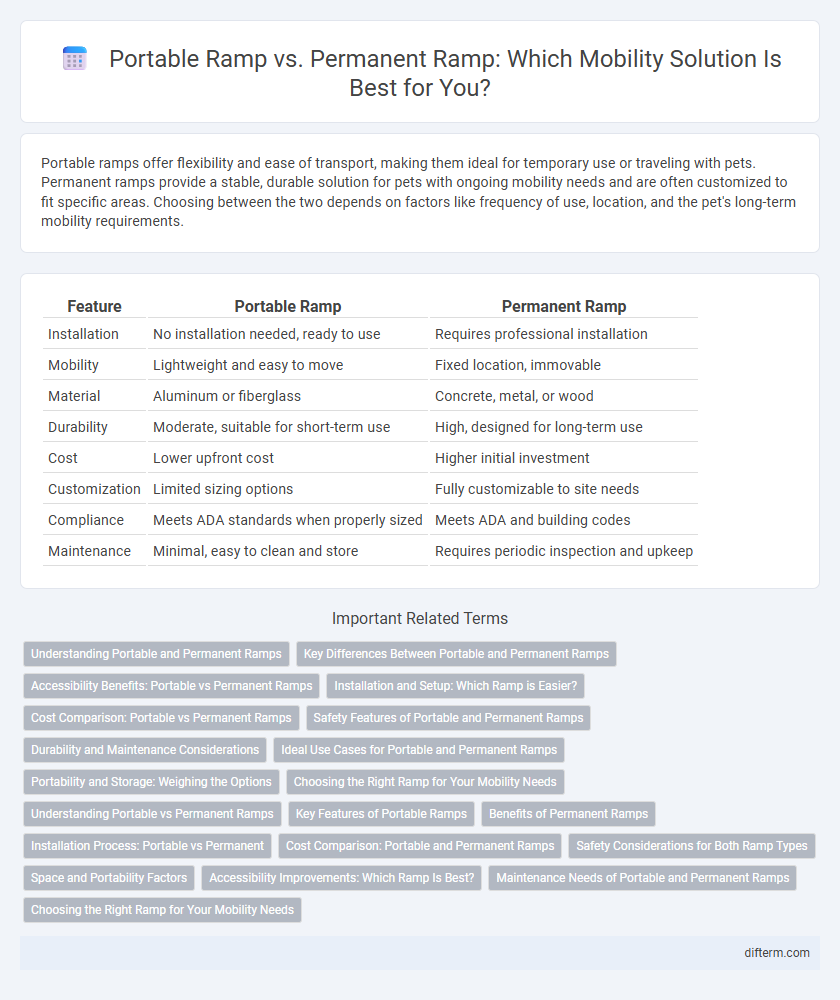Portable ramps offer flexibility and ease of transport, making them ideal for temporary use or traveling with pets. Permanent ramps provide a stable, durable solution for pets with ongoing mobility needs and are often customized to fit specific areas. Choosing between the two depends on factors like frequency of use, location, and the pet's long-term mobility requirements.
Table of Comparison
| Feature | Portable Ramp | Permanent Ramp |
|---|---|---|
| Installation | No installation needed, ready to use | Requires professional installation |
| Mobility | Lightweight and easy to move | Fixed location, immovable |
| Material | Aluminum or fiberglass | Concrete, metal, or wood |
| Durability | Moderate, suitable for short-term use | High, designed for long-term use |
| Cost | Lower upfront cost | Higher initial investment |
| Customization | Limited sizing options | Fully customizable to site needs |
| Compliance | Meets ADA standards when properly sized | Meets ADA and building codes |
| Maintenance | Minimal, easy to clean and store | Requires periodic inspection and upkeep |
Understanding Portable and Permanent Ramps
Portable ramps provide flexible, temporary access solutions that are lightweight and easy to transport, ideal for short-term or occasional use. Permanent ramps are constructed with durable materials and anchored to structures, ensuring long-term accessibility compliance with ADA standards for buildings and public spaces. Choosing between portable and permanent ramps depends on factors such as frequency of use, installation requirements, and specific mobility needs.
Key Differences Between Portable and Permanent Ramps
Portable ramps offer flexibility and easy relocation, making them ideal for temporary accessibility needs and varying environments. Permanent ramps provide durable, fixed solutions with greater structural integrity and compliance with local building codes, suited for consistent long-term use. Key differences include installation complexity, material longevity, and adaptability to different mobility devices.
Accessibility Benefits: Portable vs Permanent Ramps
Portable ramps offer flexibility and can be easily relocated to provide temporary accessibility solutions for wheelchairs and mobility devices, making them ideal for events or short-term needs. Permanent ramps ensure consistent, reliable access with durable materials designed to withstand weather and heavy use, providing long-term safety and compliance with ADA regulations. Choosing between portable and permanent ramps depends on factors like usage frequency, budget, and structural requirements for optimal accessibility.
Installation and Setup: Which Ramp is Easier?
Portable ramps require minimal setup, often featuring lightweight materials and foldable designs that enable quick installation without professional assistance. Permanent ramps involve construction work, foundation preparation, and compliance with building codes, resulting in longer installation times and higher costs. The ease of setup for portable ramps makes them ideal for temporary accessibility needs, while permanent ramps offer durable and stable solutions for long-term use.
Cost Comparison: Portable vs Permanent Ramps
Portable ramps generally have lower upfront costs ranging from $100 to $500, making them ideal for temporary or occasional use. Permanent ramps involve higher initial expenses, typically between $1,000 and $5,000, due to construction, materials, and compliance with ADA standards. Maintenance costs for permanent ramps may increase overall investment, while portable ramps require minimal upkeep but may need replacement over time.
Safety Features of Portable and Permanent Ramps
Portable ramps often include non-slip surfaces, edge guards, and lightweight materials for easy maneuverability, emphasizing user safety during temporary use. Permanent ramps incorporate sturdy construction with handrails, consistent slope gradients, and durable, weather-resistant materials to ensure long-term stability and accessibility. Both types meet ADA compliance, but permanent ramps provide enhanced safety through fixed installation and structural reinforcement.
Durability and Maintenance Considerations
Portable ramps offer flexibility and easy storage but generally have lower durability compared to permanent ramps made from concrete or steel, which withstand heavy use and harsh weather conditions. Maintenance for portable ramps involves regular inspections for wear and tear, especially in hinges and non-slip surfaces, while permanent ramps require less frequent but more intensive upkeep such as surface repairs or rust prevention. Choosing between portable and permanent ramps depends on the balance between mobility needs and long-term durability requirements.
Ideal Use Cases for Portable and Permanent Ramps
Portable ramps are ideal for temporary access needs, such as events, travel, or short-term mobility solutions, offering flexibility and easy transport. Permanent ramps suit long-term installations in homes, businesses, and public buildings, providing durable and stable access for daily use. Selecting the appropriate ramp depends on frequency of use, location, and specific mobility requirements.
Portability and Storage: Weighing the Options
Portable ramps offer the advantage of lightweight materials and foldable designs, allowing for easy transportation and compact storage in vehicles or small spaces. Permanent ramps, constructed from durable materials like concrete or metal, provide stable, fixed access but require dedicated space and cannot be relocated. Choosing between the two depends on prioritizing portability for temporary use or stability for long-term accessibility solutions.
Choosing the Right Ramp for Your Mobility Needs
Selecting the right ramp depends on your mobility requirements, space availability, and frequency of use. Portable ramps offer flexibility and easy storage, ideal for temporary access or varying locations, while permanent ramps provide durable and stable solutions for daily, long-term mobility support. Consider weight capacity, material, and incline to ensure safety and convenience tailored to individual needs.
Portable ramp vs Permanent ramp Infographic

 difterm.com
difterm.com